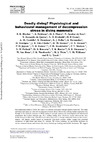Please use this identifier to cite or link to this item:
https://accedacris.ulpgc.es/handle/10553/47518
| Title: | Deadly diving? Physiological and behavioural management of decompression stress in diving mammals | Authors: | Hooker, Sascha K. Fahlman, Andreas Moore, Michael John Aguilar de Soto, Natacha Bernaldo De Quirós Miranda, Yara Brubakk, Alf Ottar Costa, Daniel P. Costidis, Alexander M. Dennison, Sophie E. Falke, Konrad J. Fernández Rodríguez, Antonio Jesús Ferrigno, Massimo Fitz-Clarke, John R. Garner, Michael M. Houser, Dorian S. Jepson, Paul D. Ketten, Darlene R. Kvadsheim, Petter Helgevold Madsen, Peter Teglberg T. Pollock, Neal W. Rotstein, David S. Rowles, Teresa K. Simmons, Samantha E. van Bonn, William G. Weathersby, Paul K. Weise, Michael J. Williams, Terrie M. Tyack, Peter L. |
UNESCO Clasification: | 240111 Patología animal 310907 Patología |
Keywords: | Dolphins Tursiops-Truncatus Gas-Bubble Lesions Foraging Behavior Beaked-Whales Heart-Rates, et al |
Issue Date: | 2012 | Publisher: | 0962-8452 | Journal: | Proceedings of the Royal Society B: Biological Sciences | Abstract: | Decompression sickness (DCS; 'the bends') is a disease associated with gas uptake at pressure. The basic pathology and cause are relatively well known to human divers. Breath-hold diving marine mammals were thought to be relatively immune to DCS owing to multiple anatomical, physiological and behavioural adaptations that reduce nitrogen gas (N-2) loading during dives. However, recent observations have shown that gas bubbles may form and tissue injury may occur in marine mammals under certain circumstances. Gas kinetic models based on measured time-depth profiles further suggest the potential occurrence of high blood and tissue N-2 tensions. We review evidence for gas-bubble incidence in marine mammal tissues and discuss the theory behind gas loading and bubble formation. We suggest that diving mammals vary their physiological responses according to multiple stressors, and that the perspective on marine mammal diving physiology should change from simply minimizing N-2 loading to management of the N-2 load. This suggests several avenues for further study, ranging from the effects of gas bubbles at molecular, cellular and organ function levels, to comparative studies relating the presence/absence of gas bubbles to diving behaviour. Technological advances in imaging and remote instrumentation are likely to advance this field in coming years. | URI: | https://accedacris.ulpgc.es/handle/10553/47518 | ISSN: | 0962-8452 | DOI: | 10.1098/rspb.2011.2088 | Source: | Proceedings of The Royal Society B-Biological Sciences [ISSN 0962-8452], v. 279 (1731), p. 1041-1050 |
| Appears in Collections: | Reseña |
SCOPUSTM
Citations
100
checked on Mar 30, 2025
WEB OF SCIENCETM
Citations
92
checked on Mar 30, 2025
Page view(s)
79
checked on Jan 25, 2025
Download(s)
100
checked on Jan 25, 2025
Google ScholarTM
Check
Altmetric
Share
Export metadata
Items in accedaCRIS are protected by copyright, with all rights reserved, unless otherwise indicated.
